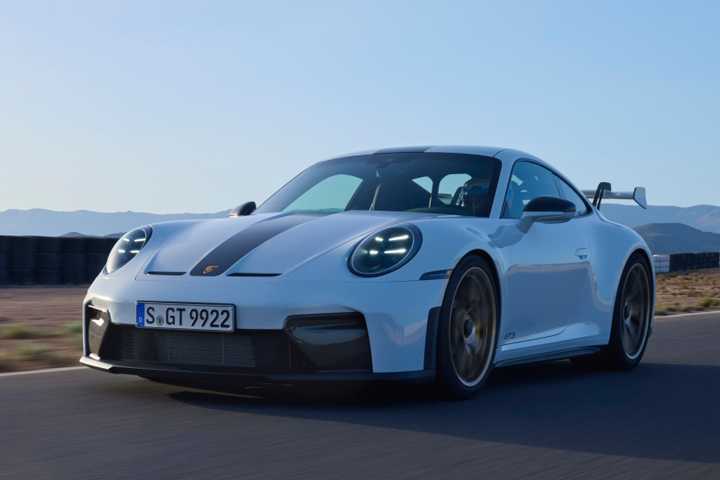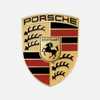Few racing circuits on Earth are as punishing and revealing as the Nürburgring Nordschleife, the legendary 12.9-mile track that has long served as the ultimate proving ground for performance cars. Manufacturers bring their latest machines here not only to chase lap records, but to validate engineering philosophies under the harshest conditions imaginable. That’s why the recent showdown between two very different machines, the 2025 Porsche 911 GT3 with a six-speed manual and the 2025 Yangwang U9 Extreme electric hypercar, captured global attention.


- Base Trim Engine
-
4.0-liter flat-6 gas
- Base Trim Transmission
-
6-Speed Manual
- Base Trim Drivetrain
-
Rear-Wheel Drive
- Base Trim Horsepower
-
502 hp
- Base Trim Torque
-
331 lb-ft
- Make
-
Porsche
- Model
-
911 GT3
- Segment
-
Sports Car
With four electric motors producing an outrageous 2,978 horsepower, futuristic torque vectoring systems, and suspension technology bordering on science fiction, it represented the peak of EV excess. The Porsche 911 GT3, by contrast, relied on a naturally aspirated flat-six producing a comparatively modest 510 horsepower and the old-school charm of a manual gearbox. Many saw this as a David versus Goliath mismatch. But when the lap times came in, the tables turned. Against all expectations, the Porsche not only held its ground, it beat the EV titan, proving once again that precision, balance, and driver engagement remain unbeatable on the world’s toughest track.
To give you the most up-to-date and accurate information possible, the data used to compile this article was sourced from various manufacturers and other authoritative sources.
David Versus Goliath: A 510-Horsepower Porsche Challenges A 3,000-Horsepower Electric Supercar
On paper, the 2025 Yangwang U9 Extreme seemed like an unstoppable force. With four electric motors producing a jaw-dropping 2,978 horsepower and a torque figure that could shame heavy-duty trucks, it entered the Nürburgring as the latest headline-grabbing hyper-EV. The car’s engineering marvels include instant torque delivery, advanced torque vectoring, and a futuristic suspension system capable of jaw-dropping feats, such as lifting wheels individually to counteract bumps. It was the type of machine designed to demolish records with raw numbers alone.
Porsche 911 GT3 And Yangwang U9 Extreme Performance Comparison
|
2025 Porsche 911 GT3 Manual (992.2) |
2025 Yangwang U9 Extreme |
|
|
Powertrain |
4.0-liter naturally aspirated flat-six (RWD) |
Quad-motor Electric (AWD) |
|
Horsepower |
510 HP |
2,978 HP |
|
Torque |
347 lb-ft |
2,200 lb-ft est. |
|
Transmission |
6-speed manual |
Single-speed |
|
Curb weight |
3,150 lbs |
5,467 lbs |
|
0-60 mph |
3.7 seconds |
1.5 seconds |
|
Top Speed |
199 mph |
192 mph |
|
Nürburgring Lap Time |
6:56.294 |
6:59.197 |
Standing in its shadow was the 2025 Porsche 911 GT3, a car powered by a naturally aspirated 4.0-liter flat-six producing “only” 510 horsepower. Even more striking was its transmission: a six-speed manual gearbox, a setup most assumed to be obsolete in the face of the lightning-fast, dual-clutch world. Against the Yangwang U9’s arsenal of computing power and electric thrust, the Porsche looked almost primitive. But what unfolded on the track shocked the automotive world.
The GT3 manual didn’t just survive against the U9 Extreme; it beat it by nearly three seconds. While the U9 did it in 6:59.197 minutes, the 911 was able to lap the ‘Ring in 6:56.294. The Porsche set a cleaner, more consistent pace, pulling ahead in technical sectors where the Yangwang’s immense power became its Achilles’ heel. What many dismissed as a hopeless mismatch quickly turned into a lesson in why balance, mechanical purity, and driver connection still matter in the age of electrification.
Why The Nürburgring Favors Precision Over Raw Power
The Nürburgring Nordschleife is often called “The Green Hell” for good reason. With over 150 corners, dramatic elevation changes, and stretches that mix long straights with blind, off-camber bends, it demands more than horsepower. To conquer the ’Ring, a car must deliver composure, predictability, and endurance. While brute force can shine on drag strips or short circuits, the Nürburgring punishes excess without finesse.
This is where the Porsche 911 GT3 has always thrived. With decades of development behind its chassis and weight distribution, the GT3 is engineered for rhythm. Its naturally aspirated engine may lack turbocharged fireworks, but its linear power delivery allows drivers to time throttle inputs with surgical precision. Meanwhile, its relatively light curb weight, nearly half of the Yangwang’s, proved to be a decisive advantage when stringing together corners that reward agility over acceleration.
The U9 Extreme’s Heavy Machinery Hindered Its Track Ability
The Yangwang U9 Extreme, despite its staggering output, struggled with the Nürburgring’s technical demands. Its massive weight, close to 6,000 pounds with batteries included, meant its brakes and tires were under constant stress. In corners, the physics simply couldn’t be ignored: the EV understeered where the Porsche danced. The Nürburgring made clear that even with futuristic engineering, pure power is only one piece of the lap-time puzzle.
The Manual Gearbox Advantage: Control, Balance, And Driver Connection
To many, the idea of a manual transmission outperforming an advanced EV system sounds absurd. After all, no human can match the millisecond precision of an electric drivetrain. But the GT3’s six-speed manual gave the driver something the Yangwang U9 couldn’t replicate: a visceral connection to the car’s dynamics. Every clutch input, every downshift, and every perfectly rev-matched corner exit allowed the driver to extract not just speed, but confidence.
Confidence is everything at the Nürburgring. Unlike a computer-controlled launch sequence, a human driver constantly makes micro-adjustments based on feel – slight corrections that prevent overdriving tires or upsetting balance. The Porsche’s gearbox became a rhythm instrument, enabling the driver to enter corners with more composure and exit them with exactly the right level of traction. Rather than relying on torque vectoring and software to keep it in line, the GT3 relied on muscle memory and mechanical purity.
The manual transmission also forced a more deliberate driving style. In a car like the Yangwang, where instant torque tempts the driver to unleash power at every opportunity, mistakes are amplified. A fraction too much throttle mid-corner could unsettle its heavy frame, costing precious tenths. In contrast, the GT3’s manual gearbox disciplined its pilot into maintaining momentum, an invaluable trait on a track that punishes hesitation or over-aggression.
Suspension, Aerodynamics, And The Art Of Cornering
Suspension and aerodynamics often separate track-focused sports cars from showpiece hypercars. Porsche’s decades of motorsport experience were evident in the GT3’s adaptive dampers, rear-wheel steering, and aggressive yet balanced aerodynamic package. Every splitter, diffuser, and winglet was engineered to maximize downforce without compromising agility. The result was a car that “shrinks” around the driver at speed, allowing them to attack corners with confidence.
The Yangwang U9 Extreme arrived with its own bag of tricks, most notably its “DiSus-X” suspension system, capable of lifting the car off the ground or even performing a “jump” to showcase engineering theatrics. While impressive for showcasing EV innovation, these features didn’t translate into lap-time superiority. On the ’Ring, what mattered was suspension communication and predictability, not acrobatics. The U9 felt like it was fighting its mass, whereas the GT3 felt naturally balanced and planted.
Porsche’s Motorsport-Derived Design On Full Display
Aerodynamics compounded this divide. The GT3’s downforce was predictable, coming on progressively as speeds climbed, while the Yangwang’s sheer bulk created aerodynamic drag that limited its effectiveness on long straights. Although the U9 had immense straight-line pace, it bled time in braking zones and corner exits, where grip and composure matter most. The Porsche reminded the world that real lap-time magic isn’t about party tricks, but about the art of cornering done right.
What This Showdown Means For The Future Of Sports Cars And EVs
The Nürburgring battle between the Porsche 911 GT3 manual and the Yangwang U9 Extreme was more than just a quirky mismatch; it symbolized a philosophical clash in automotive engineering. The Yangwang represented the new school of excess: overwhelming horsepower, digital precision, and futuristic systems. The Porsche embodied the old guard: balance, lightweight engineering, and the irreplaceable bond between driver and machine. That the GT3 emerged victorious wasn’t just about numbers; it was about proving that technology doesn’t always replace tradition.
For the future of sports cars, the GT3’s win is a rallying cry. It proves that enthusiasts still crave engagement over automation, and that the value of a manual gearbox or a naturally aspirated engine isn’t measured in acceleration times alone. In fact, the victory at the Nürburgring may inspire manufacturers to keep offering purist machines alongside their electric flagships, ensuring diversity in a market that risks becoming homogenized by EV dominance.
For EVs, the Yangwang’s loss is equally instructive. It highlights that the next phase of electric performance cannot simply be about chasing horsepower records. Engineers will need to focus on reducing weight, improving thermal management, and fine-tuning dynamics if EVs are to dominate complex tracks like the Nürburgring. Raw power made headlines, but finesse won the race. In the end, the 2025 Porsche 911 GT3 manual reminded the world that in motorsport, the heart and hands of the driver remain just as critical as the technology beneath them.










